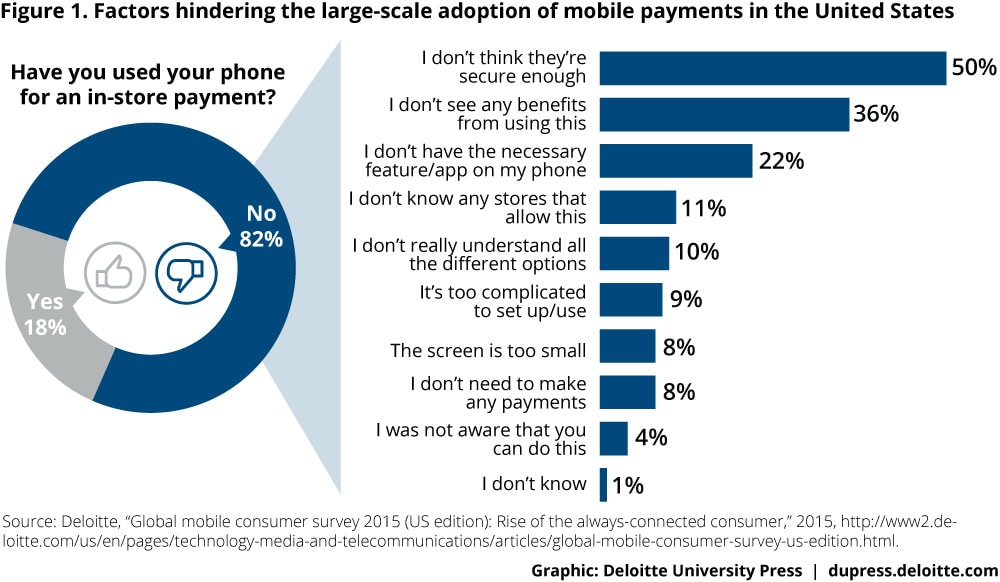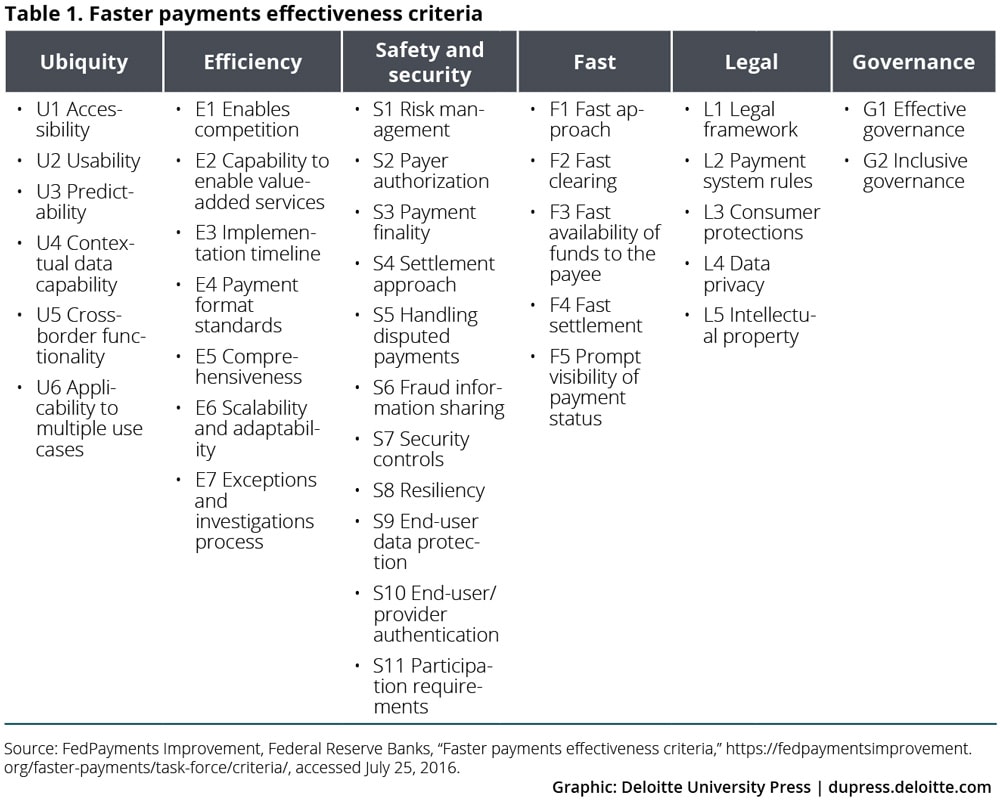Smart device, smart pay 2.0 has been saved

Smart device, smart pay 2.0 From competition to collaboration for mobile payment solutions
14 October 2016
As the number of consumers using mobile phones to make payments grows, the ecosystem of mobile payments at point of sale is being redefined—in part by faster payments systems, which hold potential benefits for both consumers as well as retailers. However, this new ecosystem creates challenges for companies more used to competing than collaborating.
AS the number of consumers using mobile phones to make financial transactions in stores grows, the ecosystem of mobile payments at point of sale (mPay-at-POS) is being redefined.1 At the same time, many central banks, governments, and payment networks across the world are implementing payment rails to speed up settlement times, including same-day Automated Clearing House (ACH) and faster payments (FPS).2
In the United States, a task force assembled by the Federal Reserve has embarked on an initiative to encourage improvements for the country’s payments system, with “faster” and “more secure” being key elements.3 Additionally, the National Automated Clearing House Association (NACHA) has introduced same-day ACH for credits this year and will begin implementing same-day debits in 2017.4
This article explores the potential impact that these new developments may have on mobile payments in the United States and in global economies. The adoption of a framework to improve settlement times may introduce significant opportunities and commensurate challenges for the technology, telecom, financial services, and retail industries in the United States.
How do companies competing in the ecosystem leverage these new developments to offer innovative mobile payments solutions for all types of payments? How do the various players in the mPay-at-POS ecosystem evolve their networks, alliances, and collaborations into a cohesive set of secure solutions? And what can banks and payment schemes in the United States learn about deploying mobile solutions on top of real-time or near-real-time payment rails? These questions are at the heart of this article.
What is holding back mobile payment adoption?
In the last year, the share of US consumers making an in-store mobile payment more than tripled from 5 percent to 18 percent, according to Deloitte’s Global Mobile Consumer Survey (US edition).5 While impressive, this growth rate is below analyst expectations.6 Factors slowing mPay-at-POS adoption include usage of smartphones with near-field communication (NFC) capability, personal information and transaction security, benefits that are not compelling enough for customers, and a lack of understanding of the different options (figure 1).
Security is the single most important reason for respondents’ low use of smartphone payments in the retailer environment, across all age demographics. Most big-box retailers have already implemented combo terminals that are capable of reading NFC and EMV (Euro-MasterCard-Visa) transactions.7 Especially considering increased transaction times with EMV, many merchants are gearing up to accept NFC transactions at peak times; consumers are likely willing to spend on high average-order-value transactions through mobile payments (for example, 12 percent of those surveyed would purchase clothing, and 10 percent for high-street shopping).8
For mobile payments to be accepted in the store, many components must work together: smartphone hardware and software, retailer POS equipment, and back-end processing systems at the acquirer.
For mobile payments to be accepted in the store, many components must work together: smartphone hardware and software, retailer POS equipment, and back-end processing systems at the acquirer. This may require explicit coordination and collaboration between players around adopting the same technology, communication protocols, security systems, financial terms, and so on. But instead of this kind of cooperation, we have what a major business newspaper described as a battle that increasingly “resembles a multifront conflict with overlapping agenda and shifting alliances.”9
The dawn of real-time and near-real-time payments in the United States and their impact on mobile payments
In 2015, a task force assembled by the Federal Reserve was asked to identify and assess approaches using FPS to improve the US payment systems.10 The task force defined 36 effectiveness criteria needed for implementing a safe, ubiquitous FPS capability (table 1). It also invited players to propose their own versions of FPS solutions that meet the effectiveness criteria.11 Ultimately, as per the criteria, an FPS solution should offer a real-time or near-real-time, 24/7, interbank account-to-account electronic fund transfer service. In addition, it should be accessible via many channels: smartphones, tablets, digital wallets. Additionally, NACHA has introduced same-day ACH for credits this year and will begin implementing same-day debits in 2017.12
While 18 countries have already implemented a version of real-time payments (RTP), 12 additional countries, including the United States, are exploring implementation (figure 2).13 Our analysis of these 18 countries highlights that in implementing a version of RTP, all payment transactions should be cleared and posted (the payment instruction information is validated and funds are made available to recipient) instantly, and then settled (between banks) within 24 hours (or the next day in a few cases).14
While 18 countries have already implemented a version of real-time payments (RTP), 12 additional countries, including the United States, are exploring implementation.
Implementation of RTP often begins with person-to-person transfer (P2P).15 Four European countries—Sweden, Denmark, Switzerland, and the United Kingdom—have implemented in-store mobile payments and are exploring ways to shift to cashless and cardless societies. (India recently launched a mobile payment solution backed by RTP that has the in-store capability as well.16) As figure 2 shows, 83 percent allowed RTP-backed mobile P2P solutions, while 28 percent had RTP-backed mPay-at-POS; 39 percent countries have adopted the ISO 20022 messaging standard;17 61 percent of countries followed deferred net settlement systems, while 28 percent had RTP systems;18 and 72 percent of countries had 24/7/365 availability of RTP systems.
From competition to collaboration for mobile payment solutions
The move to real-time and near-real-time payments likely holds the key to unlocking latent demand for mobile payment solutions, particularly in store.19 On one hand, consumers could experience improved convenience, transparency, and security. On the other hand, retailers could benefit from lower transactional costs, a faster cash-conversion cycle, and better access to consumer data.20 While the move to real-time and near-real-time payments can create new challenges, collaboration can allow ecosystem players to pool competencies, relieving the pressure on individual players and potentially leading to large-scale acceptance of mobile payment solutions.
Success is likely to go to the agile and the open—those with strategies that enable exploration, rapid sensing, and pivoting, as well as those with a willingness to share success.
Successful collaboration should likely be managed with an eye toward the bigger picture of creating customer value. This bigger picture may be the balance of power inside a group of linked companies, somewhere between the larger ecosystem dynamics and the individual relationships between collaborating firms (see the sidebar “What are constellations?”). In finding this focus, success is likely to go to the agile and the open—those with strategies that enable exploration, rapid sensing, and pivoting, as well as those with a willingness to share success. The following four strategies may help those companies involved in offering mobile payment solutions navigate constellations:
- Seek to collaborate: While M&A trends among companies highlight the significance of recombining resources to compete better, many relationships can achieve similar results.21 In particular, one-to-many relationships can find ways to collaborate, not just with each other but also with the networks each company brings: alliances, joint ventures, and previous M&A activities. This trend is likely to pick up as players realize that organic growth is limited by purely competitive strategies. What resources could help you offer mobile payment solutions more effectively if more openly shared?
- Loosen the ties that bind: This does not mean foregoing deal terms but that those terms can be made flexible, enabling partners to adjust to new circumstances and opportunities. A single payments system can offer a more efficient way to speed, ubiquity, and security. To achieve this, companies may want to encourage evolution and continued innovation. This may mean allowing companies to be involved in the development of multiple payment systems. What functions might increase innovation with involvement beyond the development of company-specific mobile payment solutions?
- Find ways to lower switching costs: This follows from the former point, but it deserves attention as a strategy on its own. Technology and related infrastructure can provide sources of rigidity in collaboration to the extent that it can raise the cost of switching among solutions. There are opportunities for new and extant players to develop software and systems that enable interoperability between the existing groups. In 2015, a leading Danish mobile payment app announced a deal in which it would become an accepted payment method for more than 30,000 Danish merchants. These merchants could easily switch to mobile payment with a minor upgrade of already-installed terminals due to improvements in interoperability.22 How can you embrace interoperability within your mobile payment solution?
- Earn by contributing to joint value, not by choking your partners: In a world where partners are loosely tied, collaboration is open, membership is fluid, and switching costs are low, how does each player capture any value? Bargaining power will likely stem from the value that each party contributes to the whole. For example in Switzerland, two major telecom players are working toward a strategic partnership to establish a countrywide, universal mobile payment solution in collaboration with banks.23 Here, firms at the center of the constellation can encourage cooperation among partners and act as a broker and glue for the grouping. What value can you provide in a collaboration to ensure growth and profitability?
As mentioned before, in the current environment, no group appears to be dominant. But this is unlikely to continue. With the move to real-time and near-real-time, network externalities are likely to play a part in concentrating profits for a few “winners.” While these winners cannot be predicted, examining the conditions under which a player might end up being profitable can help. The power of network externalities can give competitive advantage to collaborations that service large markets. We know from research in other industries that successful ecosystems do not develop on their own; they are shaped by the organizational strategies of leading players.24 It appears collaborations that have the most favorable conditions for being profitable can emerge between device-centered and infrastructure-centered models. Hybrid strategies are also possible, such as a technology/telecom player trying to gain leadership by offering payment-acceptance services. Rather than just offering the tech features of a smart device to merchants, the technology/telecom player can begin to participate in financial infrastructure services as well.
What are constellations?
The concept of multipartner “constellations” and laws of success can be found in Remix Strategy: The Three Laws of Business Combinations by Benjamin Gomes-Casseres. Used to analyze competing networks in industries ranging from semiconductors to airlines, a constellation is defined as a group of firms linked together by alliances and nested in a larger business ecosystem. As commonly used today, the term ecosystem refers to a broader and looser collection of players than a constellation—the latter can be thought of as the organizational scaffolding enabling the ecosystem to function.
In the traditional approach to strategy, the unit of analysis is either the business or the corporation as a whole. Increasingly, however, groups of firms compete against other groups—the unit of analysis thus ought to be these constellations of allied firms. Some constellations gain advantage over others because they encompass just the right resources; others gain advantage because they manage their collective resources better. The resources and competencies needed to succeed in a market can be integrated by these groupings through their various alliances, mergers, and vendor relationships. Constellation strategies involve designing and managing the organizational structures that shape the ecosystem: assembling and managing the right set of allies so that the group can compete successfully against other groupings in the same ecosystem.
As explained in Remix Strategy, three laws can determine the success of these constellations; these are variants of the same laws that typically shape the success of any business combination:
- The assets assembled in the constellation must have the potential to create more value than the players can on their own.
- The constellation must be designed and managed to realize this joint value.
- The members in the constellation must each earn a sufficient return on their efforts to provide continued incentive for their participation.
To design a strategy around these laws, it can be important to start by identifying the assets and capabilities needed for success and specify how combining these might create new value. After that, the structures of collaboration need to be developed; at this stage, it is critical to think broadly about the contract terms, and a wide number of collaboration modes might be helpful. Finally, the plan should put in place pricing models, cost- and profit-sharing mechanisms, and other terms that shape what value each party will earn from the joint effort. This pattern has been seen in industries from video and computer standards, to online music and smartphone services, to credit cards and airlines. This dynamic now appears to be playing out in the mobile payments space, and it is up to leading players to shape it to enable successful adoption.
New strategies for a changing world
With the move to real-time and near-real-time, the old model of competition may be dying: Firms can no longer depend solely on their closely held internal resources to compete against other firms. Instead, open collaboration and group competition will likely become the norm in this industry. To be able to cope with this new kind of collaborative competition, and ultimately to win with it, players will likely need to borrow strategies from other industries that have experienced this dynamic. The sooner the realization, the quicker the adjustment of strategies, the likely better for the company involved and their customers.
The implementation of the four strategies discussed above will possibly lead to better collaboration among ecosystem players. This collaboration may be critical to realizing the potential of new technologies in mobile payment solutions, particularly in store. Retailers and their customers will likely benefit from systems that are easy to use, fast, secure, and that leverage data analytics to produce consumer value. We have the technology to get there, but we may have to unlock the potential.
Methodology
The 2015 Global Mobile Consumer Survey was commissioned by Deloitte’s Global Technology, Media, and Telecommunications practice. This online survey of consumers is fielded by an independent research firm, with survey responses weighted to reflect the US population (based on 2011 census data). The survey offers insights into consumer habits, wants, and trends in the United States, with a focus on smartphones, and wearable and proximity devices and services.
© 2021. See Terms of Use for more information.








